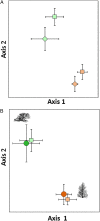Tree genetics defines fungal partner communities that may confer drought tolerance
- PMID: 28973879
- PMCID: PMC5651740
- DOI: 10.1073/pnas.1704022114
Tree genetics defines fungal partner communities that may confer drought tolerance
Abstract
Plant genetic variation and soil microorganisms are individually known to influence plant responses to climate change, but the interactive effects of these two factors are largely unknown. Using long-term observational studies in the field and common garden and greenhouse experiments of a foundation tree species (Pinus edulis) and its mutualistic ectomycorrhizal fungal (EMF) associates, we show that EMF community composition is under strong plant genetic control. Seedlings acquire the EMF community of their seed source trees (drought tolerant vs. drought intolerant), even when exposed to inoculum from the alternate tree type. Drought-tolerant trees had 25% higher growth and a third the mortality of drought-intolerant trees over the course of 10 y of drought in the wild, traits that were also observed in their seedlings in a common garden. Inoculation experiments show that EMF communities are critical to drought tolerance. Drought-tolerant and drought-intolerant seedlings grew similarly when provided sterile EMF inoculum, but drought-tolerant seedlings grew 25% larger than drought-intolerant seedlings under dry conditions when each seedling type developed its distinct EMF community. This demonstration that particular combinations of plant genotype and mutualistic EMF communities improve the survival and growth of trees with drought is especially important, given the vulnerability of forests around the world to the warming and drying conditions predicted for the future.
Keywords: climate change; drought; ectomycorrhizal fungi; host genetics; plant-soil feedback.
Conflict of interest statement
The authors declare no conflict of interest.
Figures





Comment in
-
Trees harness the power of microbes to survive climate change.Proc Natl Acad Sci U S A. 2017 Oct 17;114(42):11009-11011. doi: 10.1073/pnas.1715417114. Epub 2017 Oct 9. Proc Natl Acad Sci U S A. 2017. PMID: 29073012 Free PMC article. No abstract available.
References
-
- Bennett JA, et al. Plant-soil feedbacks and mycorrhizal type influence temperate forest population dynamics. Science. 2017;355:181–184. - PubMed
-
- Teste FP, et al. Plant-soil feedback and the maintenance of diversity in Mediterranean-climate shrublands. Science. 2017;355:173–176. - PubMed
-
- Whitham TG, et al. Community specificity: Life and afterlife effects of genes. Trends Plant Sci. 2012;17:271–281. - PubMed
-
- Johnson D, Martin F, Cairney JW, Anderson IC. The importance of individuals: Intraspecific diversity of mycorrhizal plants and fungi in ecosystems. New Phytol. 2012;194:614–628. - PubMed
-
- van der Putten WH, et al. Plant-soil feedback: The past, present and future challenges. J Ecol. 2013;101:265–276.
Publication types
MeSH terms
LinkOut - more resources
Full Text Sources
Other Literature Sources

